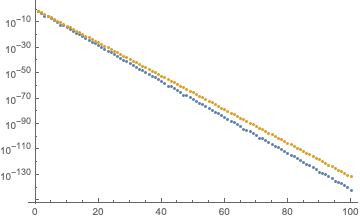Here is a another approach.
For convenience I write $n$ instead of $N$, and $A_n$ for $A$.
By definition
$$\det(A_n) = \sum_{\pi\in S_n} \operatorname{sign}(\pi) \prod_{i=1}^n a_{i,\pi(i)}$$
By assumption $A_n$ is symmetric and the $a_{i,j}$ are (for $j\geq i$) mutually independent random variables $X_{i,j}$
with $\mathbb{E}(X_{i,i})=p=:a$, $\mathbb{E}(X_{i,j})=p^2=:c$, and $\mathbb{E}(X_{i,j}^2)=p^4 +\frac{p^2(1-p^2)}{n}=:b$ for $j\not =i$.
Denote by $C(\pi)$ the set of cycles of $\pi$ and write
$\prod_{i=1}^n X_{i,\pi(i)}= \prod_{C \in C(\pi)} X_C$, with $X_C:=\prod_{i\in C} X_{i,\pi(i)}$. The cycles are disjoint, thus
the different $X_C$ are independent, further
$$\mathbb{E}(X_C)=\left\{ \begin{array}{cr} a &\mbox{ if $C$ is a fixed point}\\
b &\mbox{ if $C$ is a 2-cycle (transposition)}\\
c^{|C|} &\mbox{ if the length $|C|$ of $C$ is $\geq 3$}\end{array}\right.$$
To use that, denote by $Z_i(\pi), \,1\leq i\leq n$ the no. of cycles of length $i$ of $\pi$ and by $Z(\pi)=\sum_{i=1}^n Z_i(\pi)$
denote the total no. of cycles of $\pi$, and recall that $\operatorname{sign}(\pi)=(-1)^{n-Z(\pi)}$ ( "a permutation $\pi\in S_n$ is even iff
it's decrement $n-Z(\pi)$ is even"). We then have
$$\mathbb{E}\det(A_n)=\sum_{\pi\in S_n} (-1)^{n-Z(\pi)} a^{Z_1(\pi)} b^{Z_2(\pi)} c^{n-Z_1(\pi)-2Z_2(\pi)}$$
It is well known how to handle this type of sums. Standard generating function techniques (see e.g. section 5.2 in Stanley's EC 2) show that
$$\sum_{\pi \in S_n} t^{Z(\pi)} t_1^{Z_1(\pi)}\ldots{t_n}^{Z_n(\pi)}=n! [z^n] e^{\sum_{i=1}^n t\,t_i\frac{z^i}{i}}$$
Using that and simple manipulations we find
$$\mathbb{E}\det(A_n)=n!\,[z^n] (1+cz)\,e^{(a-c)z-(b-c^2)\frac{z^2}{2}}$$
The Hermite polynomials $He_n(x)$ are defined by $He_n(x)=n![t^n] e^{xt-\frac{t^2}{2}}$. Now note that with $v:=b-c^2$ (the variance of the off-diagonal matrix elements)
and $d:=a-c$ (the difference of the expectations) you have
$$\mathbb{E}\det(A_n)=\sqrt{v^n}\,He_n(\frac{d}{\sqrt{v}})+cn\sqrt{v^{n-1}}\,He_{n-1}(\frac{d}{\sqrt{v}})$$
The asymptotic properties of the Hermite polynomials have been intensively investigated, so you can probably find precise results for your concrete setting in the literature.
EDIT: Note that this doesn't answer your question for the expectation of the absolute value of the determinant (thanks to Carlo Beenakker for pointing this out). I'll still leave it here in case someone's interested in the expectation of the determinant.






